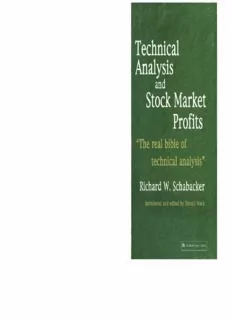
Study I
TECHNICAL APPROACH
TO STOCK TRADING
■ Definition of a Stock Chart
■ An “Advanced Course”
■ Pure Technical Action
■ Fundamentals Reflected in Technical
Action
■ Stocks Eligible for Charting
■ The Pictorial Aspect of Charts
■ Charts as the “Complete Memory”
■ Technical Chart Action – the New
Science
■ Technical vs. Fundamental Factors
■ Reasons for Contrary Technical
Action
■ Summary of the Technical Approach
■ The Introductory Warning
■ Beware of Early Presumption
■ No Easy Road to Profits
■ Newspapers which Publish Charts
■ Magazines which Publish Charts
■ Services Selling Daily Charts
■ Ready-made Charts
■ Advantages of Making Your Own
Charts
■ Closer Personal Contact
■ Number of Charts Necessary
■ Selecting the Stocks
■ Chart Paper
■ Co-ordinate Scales
■ Constructing the Scale
■ Plotting the Price Data
■ Volume of Sales
■ Shifting the Volume Chart
■ The Time Scale
■ Holidays on the Time Scale
■ Helpful Notes on “Fundamentals”
May Be Added
■ Starting a New Sheet
■ Time Range Necessary
STOCK PRICE MOVEMENTS
■ Major Movements
■ Intermediate Movements
■ Minor Movements
■ Major Trends Shown on Monthly
Charts
■ Intermediate Trends Shown by
Weekly Chart
■ Importance of Minor Movement
Study
Definition of a Stock Chart
There is perhaps no better way to begin a discussion of stock charts than to agree on
a definition for them. A stock chart is a pictorial record of the trading history of any
stock or group of stocks. This is a perfectly simple definition of our subject yet it is
general enough to cover all of the many charts, pictures and formations which we
shall discuss in subsequent pages.
A stock chart may conceivably be so simple a thing as the picture of the closing
price of one stock issue on the last trading day of each year for only five or ten years.
The picture would not mean a great deal, yet technically it would fit into our defin-
ition. It would be a pictorial record of the trading history of this stock. It would be a
stock chart. It would differ only in degree from the most complete, most detailed
and painstaking stock chart that we might construct.
An ‘‘Advanced Course’’
For the purposes of this study it will be necessary to assume that the reader is quite
familiar with stocks, with securities in general, with the theory and practice of open-
market trading and with all of the myriad technical details covered by our term
‘‘trading history.” To this extent our present study is somewhat of an ‘‘advanced
course’’ in stock market operation, and it is only fair to suggest that fundamentals of
the market be studied and mastered before undertaking to benefit from this course.
Beyond this introductory generalization, however, it shall be our constant and
continued aim to be as certain as possible that our thought is made clear by sim-
plicity of language, by constant stressing of important points, by myriad examples
and even by possibly tiresome repetition. And it will perhaps be necessary to
request the forbearance and indulgence of our ‘‘brighter pupils’’ or more experi-
enced readers if they find us apparently verging on ‘‘complete recall’’ in order to be
certain of full understanding.
As an example of this possible fault we are constrained to return for a few
moments to a more detailed examination of our introductory definition of stock
charts. The stock chart is a pictorial representation of any stock’s trading history. In
the study of stock charts we are not primarily interested in anything but actual trad-
Technical Analysis and Stock Market Profits by Richard W. Schabacker




